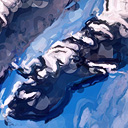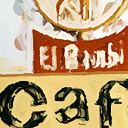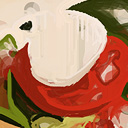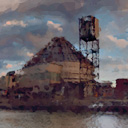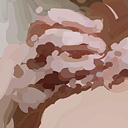May 1, 2007
Author: John Balestrieri
This section documents output from my stroke-based rendering software. These programs take a photo, drawing, collage or painting as input, then render the image as a sequence of strokes. Strokes may be very linear, as if from a pen or pencil, or wide, as from a paintbrush.
Like a camera, my software deals only with the mechanical process of recording observation. So, instead of optically focusing photons on to light-sensitive emulsion — as a camera does — my software uses principles derived from natural vision and the craft of painting and drawing.
If you think of a camera as an eye, then you might think of my software as both an eye and a hand. The obvious missing component, so far, is a brain. This brings me to a very important point:
This software is not designed to reduce Art to the push of a button. There is no substitute for human creativity & judgement. It is up to the artist, designer or illustrator — whether using canvas, camera, or computer — to use that tool in the service of their abilities.
The end product should be weighed according to this criteria, not the means of production. Any survey of the field of professional illustration will show that a human can produce mindless renderings just as easily as a camera or computer.
So, how is stroke-based rendering software used by the designer? The process is much the same as in photography: The camera permits a range of decisions to be made: focus, exposure, color or black & white, etc.. My software works similarly, with parameters controlling sketchiness, focus, detail, etc..
Although the algorithms have been developed with an eye toward producing visually pleasing results (as subjectively determined by me) — a very basic principal is at play here: Garbage in, garbage out.
Currently, there are scant parameters that can be controlled by the designer. Once the program starts running, the algorithms are sometimes applied indiscriminately. The software will gradually be developed to be better directed by the intentions of a designer, much as any other software tool such as Adobe Photoshop & Illustrator or Autodesk Maya.
This software is being developed for proprietary use and is not available for download or purchase. However, the the main rendering library used by this software will be available shortly: SuperGraphics. This library allows the stroke-based rendering software to produce both vector and bit-mapped graphics output.
Finally, thanks to everyone who has a source image image here, whether it was a photo or drawing, for granting permission to subject your image to such terrible computation…
Update: June 20, 2007 — I’ve put this project on the back burner while I experiment with some new machine vision algorithms.
